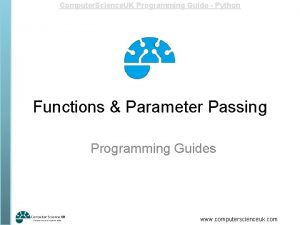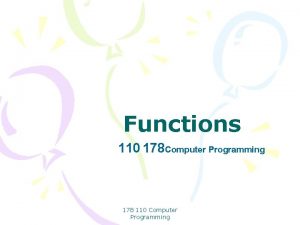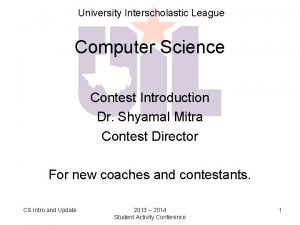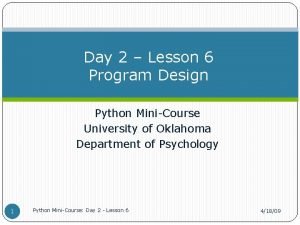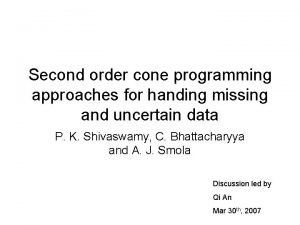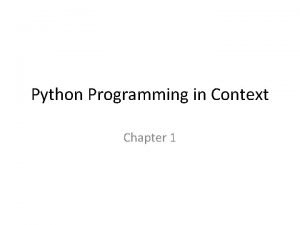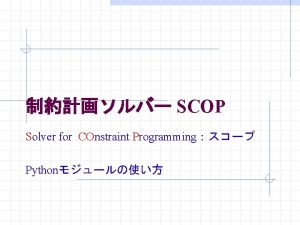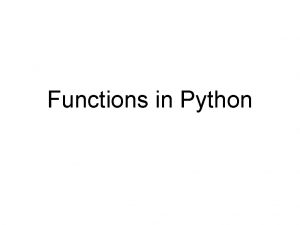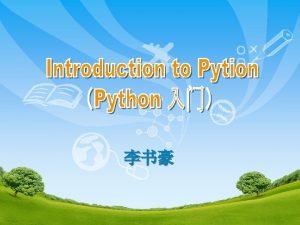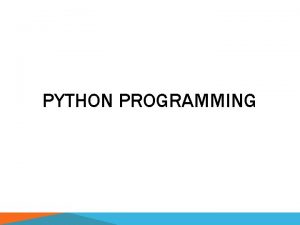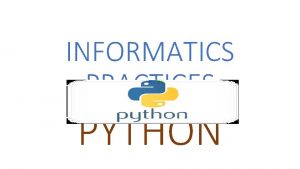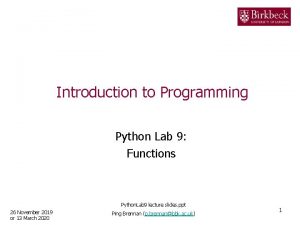Computer Science UK Programming Guide Python Functions Parameter










- Slides: 10

Computer. Science. UK Programming Guide - Python Functions & Parameter Passing Programming Guides www. computerscienceuk. com

Computer. Science. UK Programming Guide - Python Functions & Parameter Passing Introduction to Parameter Passing (passing values into procedures) As we have already seen, we can use procedures to better organise our code so that finding errors and editing the code can become easier This is because major sections of our code is self-contained and separate from one another One problem with the way we have previously written procedures is that the data inside it stays inside it. www. computerscienceuk. com

Computer. Science. UK Programming Guide - Python Functions & Parameter Passing So, if I wanted to write a program which printed the 10 times table I might write a procedure like this: Q. What if I wanted this program to allow the user to select a times table of their choice? Using our current knowledge, I would have to create a procedure for each times table and then ask the user to select their choice. www. computerscienceuk. com

Computer. Science. UK Programming Guide - Python Functions & Parameter Passing Here, you can see that the use of procedures written in this way has a drawback. Although it is great that our code is self-contained, the issue is that the code is being duplicated (with only minor changes) Programmers like efficiency, and duplicating code is not efficient! www. computerscienceuk. com

Computer. Science. UK Programming Guide - Python Functions & Parameter Passing In order to be more efficient (less code) what we really want is to have one procedure to do the multiplication and PASS the users times table choice into the procedure. This procedure here how takes on the value passed to it from the main program. A value is being passed into it for processing. This value is known as a parameter and this process is called parameter passing www. computerscienceuk. com

Computer. Science. UK Programming Guide - Python Functions & Parameter Passing The value in choice is being passed into a variable/parameter called number in the timestable function. Important to realise that the variable name of the value being passed doesn’t have to match the destination variable name. www. computerscienceuk. com

Computer. Science. UK Programming Guide - Python Functions & Parameter Passing Introduction to Functions The previous example showed how data can be passed into a procedure. A function is a procedure that can also return data back into the main program. This can be highly useful in programming. The way to do this is to assign a variable to the function call so that the variable is assigned any value that the function returns. variable_name = function_name(parameter) www. computerscienceuk. com

Computer. Science. UK Programming Guide - Python Functions & Parameter Passing Example of parameter passing and returning values: sing Pas eter ram a pa ng urni Ret alue av Here the arrows show data is being passed from the main program into the functions parameter ‘x’. Num 1 (here) is as a parameter and contains an argument (an item of data) which is passed to the functions parameter (x). When the function is finished executing its commands it returns the value back into the main program. The value is returned into the variable that the function call is assigned to (in this case it is ‘answer’). www. computerscienceuk. com

Computer. Science. UK Programming Guide - Python Functions & Parameter Passing and Returning more than one value (argument) Here the arrows show 2 parameters (each containing arguments) are being passed from the main program into the functions parameter ‘x’ and ‘y’. It is important to realise that the names of the parameters passing the values and the parameter names of the function do not have to match. However, the order in which they are sent is the order in which they are received (num 1 is sent to x, num 2 is sent to y) www. computerscienceuk. com

Computer. Science. UK Programming Guide - Python Functions & Parameter Passing and Returning more than one value (argument) Here, the arrow highlighting the ‘return’ is showing how 2 pieces of data can be returned into the main program. Of course many more could be returned in one go in this same manner. As these values are being returned to one variable ‘answer’, the variable automatically becomes a tuple, which is a data type that can hold a number of different values (like a ‘list’, but tuples are not editable (immutable)) www. computerscienceuk. com
 Python programming an introduction to computer science
Python programming an introduction to computer science Parameter computer science
Parameter computer science Nocti computer programming
Nocti computer programming What is parameter in programming
What is parameter in programming Uil computer science programming problems
Uil computer science programming problems Eric’s favourite .......... is science. *
Eric’s favourite .......... is science. * Python procedural programming
Python procedural programming Python chapter 5
Python chapter 5 Second order cone programming python
Second order cone programming python Python programming in context
Python programming in context Constraint programming python
Constraint programming python

